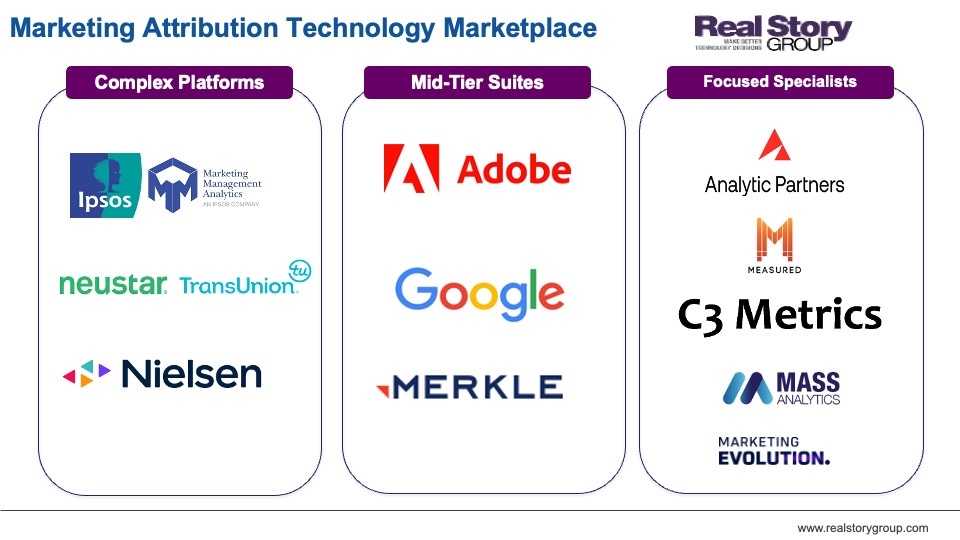In a tough economy, marketing leaders must account for every dollar of their budget and tie spending to meaningful outcomes. Adding marketing attribution technology (MAT) to your content tech stack can help put those capabilities into your entire team’s hands – if you find the right-fit platform.
MAT employs various measurement and attribution methodologies that can show you where and how your marketing efforts are adding value to your business. For example, it can be used to quantify the revenue generated through your marketing initiatives or help tie your content activities across various channels to critical outcomes and goals.
Overall, marketing attribution technology supports a diverse array of use cases, spanning various business objectives and channel support. However, vendors’ offerings can vary widely in their target use cases and their attribution methodologies.
It makes MAT a challenging market to navigate when considering a purchase. However, tracking key details can help you decide if a MAT solution is worth adding to your martech stack and find the optimal vendor for your content team’s needs.
Understand MAT marketplace distinctions
For our tech evaluations at Real Story Group (RSG), we divide the MAT marketplace into three general categories based on how their capabilities are packaged and the marketer use cases they target:
- Complex platforms: In this category, vendors offer marketing attribution functionality as part of a larger marketing data management portfolio. These platforms are ideal for enterprise brands with highly complex use cases – for example, if you need to integrate MAT with other data management capabilities, like identity resolution. Such vendors include Ipsos, Marketing Management Analytics, Neustar (a TransUnion Company), and Nielsen.
- Mid-tier suites: In this category, marketing attribution functionality is also offered within a broad suite of tools. However, these platforms, offered by vendors like Google, Adobe, or Merkle, are best suited for brands with fewer platforms or channels in their marketing mix.
- Focused specialists: These solutions solely provide marketing attribution (or a subset of MAT) functionality. They’re most appropriate for brands that need robust capabilities in one specific attribution methodology, such as marketing mix modeling. Analytics Partners, Measured, C3 Metrics, Mass Analytics, and Marketing Evolution are among the vendors in this category.
An overview of the marketing attribution technology marketplace. Source: RSG research.
Explore approaches by use case
For marketing attribution, we categorize marketplace solutions by their core focus. They’re divided into five archetypal business use cases, which we call “scenarios.”
Your use cases will probably comprise some combinations (or variations) of the scenarios below, which makes it challenging to map categories and use cases directly. But the insights below can give you a good starting point for analyzing and vetting right-fit candidates.
Scenario 1: Marketing mix modeling (MMM)
You’re likely familiar with marketing mix modeling. This top-down statistical analysis approach gauges the current impact of your marketing tactics to forecast how they’re likely to perform in the future.
This model is based on standard economic metrics that are relatively stable across industries, which makes it ideal for long-term planning and strategic decision-making. However, you’ll need to gather historical data (time series and aggregate), industry benchmarks, and other longitudinal data in advance to generate valuable insights.
Scenario 2: Multi-touch attribution (MTA)
Consumers interact with your marketing campaigns at multiple touchpoints across your brand’s content experience, such as your websites, paid ads, social media posts, mobile apps, and emails. But how significant a role does each touchpoint – or each content asset offered there – play in driving a conversion?
MTA can give you an answer by assigning each touchpoint a weight (or credit) according to its contribution to your conversion goal. It can also provide insights to help you determine the ROI from your remarketing campaigns or which channels are most effective for nurturing consumers down your funnel.
Scenario 3: Omnichannel attribution
In addition to various media touchpoints, a customer’s journeys can span multiple channels and devices. Think of omnichannel attribution as a more advanced form of MTA in that it considers all these variants and ties them together.
This scenario becomes increasingly crucial as traditional marketers increase digital investments and digital marketers invest more in traditional media.
Scenario 4: B2B attribution
Compared with B2C, B2B brands commonly have longer sales cycles. B2B purchase processes can also be more complex, involving multiple decision-makers who operate across various functional teams.
B2B attribution is a relatively new use case that emerged to accommodate the unique characteristics of the B2B customer journey. It strongly emphasizes first-party data (from your CRM or website) and measures more offline touchpoints (e.g., outbound sales).
Scenario 5: TV attribution
Television long predates digital as a marketing medium, but TV campaign measurement has historically suffered from marketers’ lack of access to granular consumer data.
This has changed thanks to the advent of set-top boxes and smart TVs and advances in content tagging, data collection, and measurement. TV attribution links the impact of TV exposures to marketing metrics and sales outcomes, enabling marketers to measure the impact of these campaigns more accurately.
Develop a vendor shortlist
Vendors in the marketing attribution space all claim to be leaders in some respect. But your job as a content leader is to look beyond the hype and identify the best-fit solutions for your content team’s needs and operating conditions.
Following these three steps can help you vet the available solutions and create a shortlist of vendors to consider:
“As a content leader, your job is to look beyond vendor hype and identify the best-fit marketing attribution solution.”
Step 1: Filter vendors by platform
Given how long it would take to vet every available MAT solution, you’ll need ways to filter out vendors from your consideration set. Start your evaluation at the platform level: Which of the three categories listed above (complex, mid-tier, or focused) best matches the needs and conditions of your content program?
Here, you’ll want to account for your organization’s architecture-related needs and data management requirements. Also, consider your vendor service needs. For example, if you are based in Europe, you may want to eliminate vendors whose support teams don’t operate in your time zone.
Step 2: Gauge your scenarios against vendor strengths and weaknesses
Nearly all the vendors shown in the marketplace graphic above will claim they can handle all five scenarios. However, our experience has found that most tend to specialize in a limited set of scenarios.
You will want to ensure your use case priorities align with the strengths of the MAT vendors you consider. While you can often stretch a platform to support use cases that are not a vendor’s strength, the adaptation efforts required may take more resources and budget than your team can spare.
As an example, consider a hypothetical B2B equipment manufacturing firm. This firm wants to address B2B attribution as its key requirement and doesn’t consider other scenarios relevant. Based on support for this B2B scenario, shortlisted vendors would likely include Adobe, Merkle, and Analytics Partners.
Another hypothetical: A fast-moving consumer goods (FMCG) firm wants to focus on omnichannel attribution. This firm’s shortlist will likely differ significantly from the equipment manufacturing firm’s. For example, Adobe may not be ideal to support omnichannel attribution (though the vendor may disagree with that estimation), but Ipsos and Nielsen support this scenario well.
For your evaluation, we recommend the following process:
- Define your business use cases. If some are a higher priority, ranking them on your list may be helpful.
- Research vendors in the most appropriate category. As you evaluate their key strengths and weaknesses, consider any shortfalls that might prevent you from implementing your use cases.
- Track and analyze your resulting data. Compare and contrast insights you’ve collected to create a shortlist of the vendors that best match your critical use cases.
Step 3: Apply an agile testing and selection methodology
You’ll find it useful to employ a forward-thinking, agile approach when making your final selection. The significance of thoroughly testing MAT platforms before committing to a licensing agreement can’t be underscored.
Start with building a cross-functional selection team chaired by a business stakeholder. Invite representatives from data and IT teams to join this committee if possible: Their expertise is crucial at this stage, as it can help you avoid technical issues when implementing and working with your chosen platform.
We recommend an iterative process to test-drive various MAT products using your own use cases. It will give everyone empirical touchpoints and results, which smooths alignment around decision-making.
Structure your test drives as week-long sprints, with requisite business and technical teams involved, followed by a competitive “bake-off” – a head-to-head test of your top finalists. If a vendor hesitates or resists participating in this testing phase, take it as a red flag and consider dropping them from your consideration list.
For the best results with this process, follow these key recommendations:
- Do NOT issue checklist RFPs. Avoid vendor comparisons using a long list of requirements in Excel – most vendors always get a tick mark in each row. Knowing how each vendor will address each requirement is more important than knowing if they can.
- Focus on what makes your marketing needs unique. Apply your own use cases and data to test drives rather than the default test cases and data a vendor may provide. We also recommend using a scenario-based approach for selection rather than a functionality-based one.
- Consider both functional and strategic capabilities. We suggest structuring this evaluation as follows:
- Vendor: Customer support, strategy, professional services, viability, and stability
- Product: Roadmap, technical modernity, value for money
- Ecosystem: Channel, professional services, community strength, and third-party add-ons
Activate the benefits of marketing attribution
You can optimize your digital advertising and marketing spend by deploying marketing attribution technology. But to achieve those goals, you must select the right vendor and product for your content program.
Compared to systems in other martech categories, we’ve found that MAT marketplace offerings are relatively less “out of the box.” For example, in our vendor evaluation research, licensees commonly find these complex technologies challenging to integrate and implement without ample vendor assistance, which costs money. Further, getting the specific insights you need to inform your content strategy can come with a steep learning curve that burdens your team’s time and resources.
Exercise caution when considering solutions in this dynamic landscape and conduct thorough testing before committing to contracts. You’ll also want to ensure your team is appropriately resourced for the long haul.
The payoff? You can better determine which marketing investments drive key outcomes and prove the business value of your team’s marketing initiatives to stakeholders and executives.


